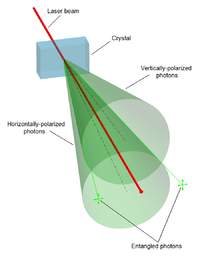
Photo from wikipedia
The measurement of the correlation between two quantum systems or particles has a broad significance in physics and also plays a central role in the fields of quantum optics and… Click to show full abstract
The measurement of the correlation between two quantum systems or particles has a broad significance in physics and also plays a central role in the fields of quantum optics and quantum information science. We propose a method of measuring the correlation between the transverse momenta of two photons, in which one only needs to detect one of the photons. We show that it is possible to generate a single-photon fringe pattern by using two spatially separated identical biphoton sources. The fringes are similar to the ones observed in a Michelson interferometer and possess certain remarkable properties. A striking feature of the fringes is that although the pattern is obtained by detecting one photon only of each photon pair, the fringes shift due to a change in the optical path traversed by the undetected photon; the shift is characterized by a combination of wavelengths of both photons. Using this method one can, therefore, measure the wavelength of a photon without detecting it. The visibility of the fringes diminishes as the correlation between the transverse momenta of twin photons decreases: visibility is unity for maximum momentum correlation and zero for no momentum correlation. This dependence allows us to determine the momentum correlation between both photons from the visibility of the fringe pattern obtained by detecting one of the photons only. Our method can potentially be generalized to other quantum entities.
Journal Title: Physical Review A
Year Published: 2017
Link to full text (if available)
Share on Social Media: Sign Up to like & get
recommendations!